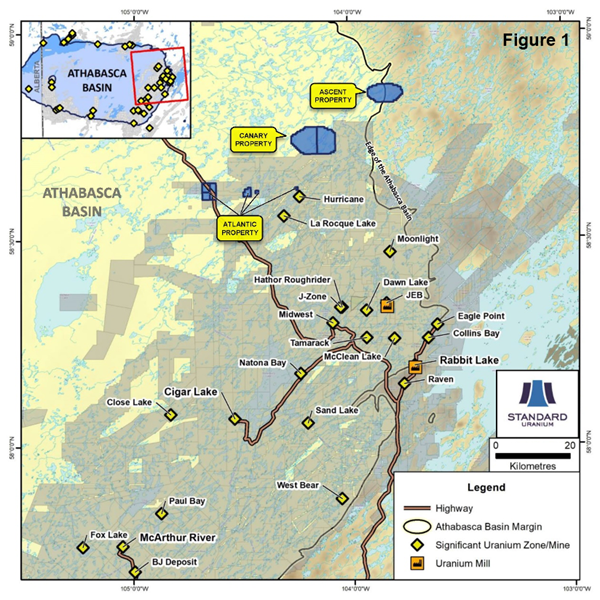Jul 13 2020
Standard Uranium Ltd, a mineral resource exploration company, is happy to announce that two new projects, located in the eastern Athabasca Basin and totaling 11,040 ha, have been acquired through staking.
 Standard Uranium Canary and Ascent Projects relative to Atlantic Property. Image Credit: Standard Uranium Ltd.
Standard Uranium Canary and Ascent Projects relative to Atlantic Property. Image Credit: Standard Uranium Ltd.
Located 40 km northeast of Standard Uranium’s Atlantic project, the new Canary and Ascent Projects stretch about 12 and 33 km, respectively, from IsoEnergy’s Hurricane Zone at the latter’s Larocque East Project.
Canary Project Highlights
- Two claims total up to 7,303 Ha.
- Depth to the sub-Athabasca unconformity has been identified to range from 84 to 230 m from the surface.
- Three conductive corridors were detected by historical airborne EM work conducted from 1993 to 2006. These corridors were identified to be graphitic meta-sediments that are prospective host rocks for uranium mineralization.
- Two prospective target regions on the property, associated with structural disruptions of the conductive corridors, have been confirmed by historical ground EM and IP surveys.
- Highly anomalous uranium enrichment was identified by historical drill-hole CRK-137. This uranium enrichment is close to the unconformity with 10 ppm uranium across 7.4 m in systematic composite sampling of the sandstone. Robust hydrothermal alteration was also detected all through the interval. Inside this zone, a discrete 0.5-m sub-interval yielded 103.1 ppm uranium, and a 1.0-m interval in the graphitic meta-sediments directly below the unconformity yielded 200.0 ppm uranium.
- Drilling was performed in which only one of the three conductive targets was tested, and the one that has been tested is believed to be extremely anomalous.
Ascent Project Highlights
- One claim totals up to 3,737 Ha.
- Depth to the sub-Athabasca unconformity has been identified to range from 0 to around 50 m from the surface. There is no Athabasca sandstone cover on the eastern section of the project.
- In previous airborne EM work conducted in 1979 and 2006, a huge, 3-km wide and 6-km long conductive corridor was detected; this corridor has various target regions associated with prospective cross structures.
- In the early 1980s, the region was surrounded with ground EM surveys and validated the airborne targets.
- A lake sediment sampling program conducted in 1979 detected a very high-priority Radon-U-Co-Ni-Zn-Mo-Pb-V anomaly situated directly over the conductive target.
- Regional prospecting performed by previous operators revealed uranium enrichment in basement rocks situated east of the Athabasca Basin edge, and supports the exploration model for uranium found on the property.
- In 1984, only a single drill-hole has tested the wide-ranging conductive corridor, with 6 km of strike length that is yet to be tested.
- The present exploration model meant for this project is similar to that of the Roughrider and J-Zone deposits, situated adjacent to an analogous looking airborne EM target. The dimensions of this EM target are about 1-km wide by 2-km long.
- Standard Uranium believes that the two targets at the Ascent project and the Roughrider and J-Zone deposits are shallow-dipping conductive bodies, and hence did not fit the historical exploration model of an excellent conductor to focus on.
Both the new projects have bolstered Standard Uranium’s presence in the Eastern Athabasca Region, and compliment the company’s prevalent Atlantic Project. The new projects could be analyzed simultaneously to save costs in upcoming exploration programs.
Furthermore, the Eastern Athabasca Basin area has been the center of uranium exploration and mining for the past five decades, and the area has been delineated by three licensed uranium mills.
Although the area has been the backbone of uranium exploration, many significant uranium findings, such as J-Zone, Roughrider, Fox Lake, Gryphon, and Phoenix, have been made in the past 12 years.
The northern section of the Eastern Athabasca Basin has witnessed comparatively less drilling when compared to the rest of the area. Standard Uranium’s Ascent, Canary, and Atlantic projects are located in this Eastern Athabasca Basin.
Standard Uranium has also defined this northern portion as an excellent opportunity to add value and raise the chances for a novel discovery in regions that have fundamentally robust geology and have yielded positive historical exploration outcomes.
Atlantic Project Highlights
- Six claims total up to 2,176 Ha.
- The Atlantic project covers 6.5 km of an 18-km long, east-west trending conductive exploration trend, situated due west of Hurricane Zone that belongs to IsoEnergy.
- Depth to the sub-Athabasca unconformity has been identified to range from 230 to 485 m from the surface.
- In 1992, Cameco conducted historical drilling (hole BE-04) that encountered up to 586 pm uranium across 0.5 m in the sandstone, close to the unconformity. The BE-04 hole also encountered elevated nickel, uranium, chlorite, and illite in the lower 10 m of sandstone.
- In 2012 Denison Mines conducted a follow-up drilling program (Hole BL12-13), adjacent to BE-04 hole and encountered a fault-zone situated 130 m above the sandstone containing 2,270 ppm zinc, 786 ppm lead, 10.2 ppm uranium, as well as other base-metals across 0.1 m. Moreover, a composite sample of the basal 13.4 m of sandstone yielded 477 ppm uranium.
- In 2016, Denison Mines conducted a drilling operation at the western claim block (Hole BL16-32) and detected 342 ppm uranium across 0.5 m at the base of the sandstone.
We are committed to success at our flagship Davidson River Property in the southwest Athabasca region where our maiden drill program will commence within the month given that the COVID-19 situation remains stable. In the meantime, we have been actively reviewing new projects that contain technically strong exploration targets with discovery potential to round out our portfolio in a proven uranium exploration and mining region with relatively shallow target depths.
Neil McCallum, VP Exploration, Standard Uranium Ltd